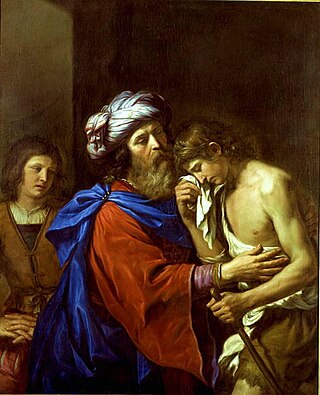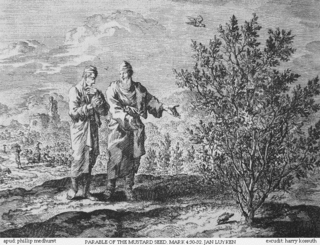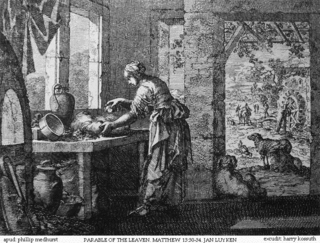Related Research Articles

The Gospel of Mark is the second of the four canonical gospels and one of the three synoptic Gospels. It tells of the ministry of Jesus from his baptism by John the Baptist to his death, burial, and the discovery of his empty tomb. It portrays Jesus as a teacher, an exorcist, a healer, and a miracle worker, though it does not mention a miraculous birth or divine pre-existence. He refers to himself as the Son of Man. He is called the Son of God but keeps his messianic nature secret; even his disciples fail to understand him. All this is in keeping with Christian interpretation of prophecy, which is believed to foretell the fate of the messiah as suffering servant.

The Gospel of John is the fourth of the four canonical gospels. It contains a highly schematic account of the ministry of Jesus, with seven "signs" culminating in the raising of Lazarus and seven "I am" discourses culminating in Thomas' proclamation of the risen Jesus as "my Lord and my God". The gospel's concluding verses set out its purpose, "that you may believe that Jesus is the Christ, the Son of God, and that believing you may have life in his name."
Gospel originally meant the Christian message, but in the 2nd century it came to be used also for the books in which the message was reported. In this sense a gospel can be defined as a loose-knit, episodic narrative of the words and deeds of Jesus, culminating in his trial and death and concluding with various reports of his post-resurrection appearances. Modern biblical scholars are cautious of relying on the gospels uncritically, but nevertheless, they provide a good idea of the public career of Jesus, and critical study can attempt to distinguish the original ideas of Jesus from those of the later Christian authors.

The Last Supper is the final meal that, in the Gospel accounts, Jesus shared with his apostles in Jerusalem before his crucifixion. The Last Supper is commemorated by Christians especially on Holy Thursday. The Last Supper provides the scriptural basis for the Eucharist, also known as "Holy Communion" or "The Lord's Supper".

The Gospel of Thomas is an extra-canonical sayings gospel. It was discovered near Nag Hammadi, Egypt, in December 1945 among a group of books known as the Nag Hammadi library. Scholars speculate that the works were buried in response to a letter from Bishop Athanasius declaring a strict canon of Christian scripture. Scholars have proposed dates of composition as early as 60 AD and as late as 250 AD. Since its discovery, many scholars have seen it as evidence in support of the existence of a "Q source" which might have been very similar in its form as a collection of sayings of Jesus without any accounts of his deeds or his life and death, referred to as a sayings gospel.

The parable of the Good Samaritan is told by Jesus in the Gospel of Luke. It is about a Jewish traveler who is stripped of clothing, beaten, and left half dead alongside the road. First, a Jewish priest and then a Levite come by, but both avoid the man. Finally, a Samaritan happens upon the traveler. Although Samaritans and Jews despised each other, the Samaritan helps the injured man. Jesus is described as telling the parable in response to a provocative question from a lawyer, "And who is my neighbor?", in the context of the Great Commandment. The conclusion is that the neighbor figure in the parable is the one who shows mercy to their fellow man.

The Jesus Seminar was a group of about 50 biblical criticism scholars and 100 laymen founded in 1985 by Robert Funk that originated under the auspices of the Westar Institute. The seminar was very active through the 1980s and 1990s, and into the early 21st century.

In Christianity, Jesus is the Son of God as written in the Bible's New Testament, and in mainstream Christian denominations he is God the Son, the second Person in the Trinity. Christians believe him to be the Jewish messiah prophesied in the Hebrew Bible. Through Jesus's crucifixion and alleged resurrection, God reputedly offers humans salvation and eternal life, with Jesus's death interpreted as atoning for all sin, thus making humanity right with God.

Jesus, also referred to as Jesus Christ or Jesus of Nazareth, was a first-century Jewish preacher and religious leader. He is the central figure of Christianity, the world's largest religion. Most Christians believe he is the incarnation of God the Son and the awaited Messiah prophesied in the Hebrew Bible.

Form criticism as a method of biblical criticism classifies units of scripture by literary pattern and then attempts to trace each type to its period of oral transmission. "Form criticism is the endeavor to get behind the written sources of the Bible to the period of oral tradition, and to isolate the oral forms that went into the written sources. Insofar as this attempts to trace the history of the tradition, it is known as tradition criticism." Form criticism seeks to determine a unit's original form and the historical context of the literary tradition.

The Parable of the Ten Virgins, also known as the Parable of the Wise and Foolish Virgins or the Parable of the ten bridesmaids, is one of the parables of Jesus. According to Matthew 25:1–13, ten virgins await a bridegroom; five have brought enough oil for their lamps for the wait, while the oil of the other five runs out. The five virgins who are prepared for the bridegroom's arrival are rewarded, while the five who went to buy further oil miss the bridegroom's arrival and are disowned.

The parables of Jesus are found in the Synoptic Gospels and some of the non-canonical gospels. They form approximately one third of his recorded teachings. Christians place great emphasis on these parables, which they generally regard as the words of Jesus.

The Parable of the Mustard Seed is one of the shorter parables of Jesus. It appears in Matthew (13:31–32), Mark (4:30–32), and Luke (13:18–19). In the Gospels of Matthew and Luke, it is immediately followed by the Parable of the Leaven, which shares this parable's theme of the Kingdom of Heaven growing from small beginnings. It also appears in the non-canonical Gospel of Thomas.

The Parable of the Lost Coin is one of the parables of Jesus. It appears in Luke 15:8–10. In it, a woman searches for a lost coin, finds it, and rejoices. It is a member of a trilogy on redemption that Jesus tells after the Pharisees and religious leaders accuse Him of welcoming and eating with "sinners." The other two are the Parable of the Lost Sheep, and the Parable of the Lost Son or Prodigal Son.

The Parable of the Leaven, also called the parable of the yeast, is one of the shortest parables of Jesus. It appears in Matthew 13:33 and Luke 13:20–21, as well as in the non-canonical Gospel of Thomas. In the canonical gospels it immediately follows the Parable of the Mustard Seed, which shares this parable's theme of the Kingdom of Heaven growing from small beginnings. In the Gospel of Thomas it starts a series of three, preceding the Parable of the empty jar and the Parable of the Strong Man.

Jesus' parable of drawing in the net, or the parable of the dragnet, appears in Matthew 13:47–52 and refers to the final judgment. This parable is the seventh and last in Matthew 13, which began with the parable of the Sower. It directly follows the Parable of the Pearl, which is about the Kingdom of God. Thus, it links the Kingdom of God with the final judgment—the separation for hell and heaven. Jesus told the parable to his disciples.

Luke 13 is the thirteenth chapter of the Gospel of Luke in the New Testament of the Christian Bible. It records several parables and teachings told by Jesus Christ and his lamentation over the city of Jerusalem. Jesus resumes the journey to Jerusalem which he had embarked upon in Luke 9:51. The author of this chapter is unattributed, however early Christian tradition generally accepts that Luke the Evangelist composed this Gospel as well as the Acts of the Apostles.
The Parable of the [Wise] Assassin, is a parable attributed to Jesus. However, it appears in none of the Canonical gospels of the New Testament but only in the non-canonical Gospel of Thomas. According to the Gospel of Thomas 98 Jesus said:
The kingdom of the father is like a certain man who wanted to kill a powerful man. In his own house he drew his sword and stuck it into the wall in order to find out whether his hand could carry through. Then he slew the powerful man.

The Parable of the strong man is a parable told by Jesus in the New Testament, found in Matt 12:29, Mark 3:27, and Luke 11:21–22, and also in the non-canonical Gospel of Thomas where it is known as logion 35

Oral gospel traditions is the hypothetical first stage in the formation of the written gospels as information was passed by word of mouth. These oral traditions included different types of stories about Jesus. For example, people told anecdotes about Jesus healing the sick and debating with his opponents. The traditions also included sayings attributed to Jesus, such as parables and teachings on various subjects which, along with other sayings, formed the oral gospel tradition. The supposition of such traditions have been the focus of scholars such as Bart Ehrman, James Dunn, and Richard Bauckham, although each scholar varies widely in his conclusions, with Ehrman and Bauckham publicly debating on the subject.
References
- 1 2 "Gospel of Thomas". Gnosis.org. The Nag Hammadi Library. Translated by Lambdin. Retrieved 26 February 2014.
- ↑ Funk, Robert Walter (1997). The Five Gospels: What Did Jesus Really Say? the Search for the Authentic Words of Jesus (first paperback ed.). Harper Collins. p. 552. ISBN 0-06-063040-X.
the five gospels assassin
- ↑ "Jesus Seminar Preface". Veritas-ucsb.org. Retrieved 26 February 2014.
- ↑ Chilton, Bruce; Evans, Craig A., eds. (1999). "Five Gospels but No Gospel" (PDF). Leiden: Brill. pp. 83–120. Archived from the original (PDF) on 22 December 2004. Retrieved 26 February 2014.
originally published in Authenticating the Activities of Jesus
- ↑ Hultgren, Arland J. (2002). The Parables of Jesus: a commentary. Grand Rapids, Michigan/Cambridge, U.K.: Wm. B. Eerdmans Publishing. p. 443. ISBN 0-8028-6077-X.
- ↑ Bromiley, Geoffrey W, ed. (1994). "Apocryphal gospels". International Standard Bible Encyclopedia. Vol. 1. Grand Rapids, Michigan: Wm. B. Eerdmans Publishing. p. 186. ISBN 0-8028-3781-6.
- ↑ Valantasis, Richard (1997). The Gospel of Thomas. London and New York: Routledge. p. 178. ISBN 0-415-11622-8.
- ↑ Jones, Peter Rhea (1997). Studying the Parables of Jesus. Macon, GA: Smyth & Helwys Publishing, Inc. p. 34. ISBN 1-57312-167-3.
- ↑ Amundsen, Christian (1999). Insights/Secret Teachings of Jesus: The Gospel of Thomas. Sunstar Publishing Ltd. p. 230. ISBN 1-887472-57-6.
- ↑ Shortell, Ray (2021). The Anti-Judaism of the Bible. Canton, GA: Ray Shortell. p. Part IV - The Antisemitic Metaphors of Alexandria (Thomas and Matthew). ISBN 9798779567169.